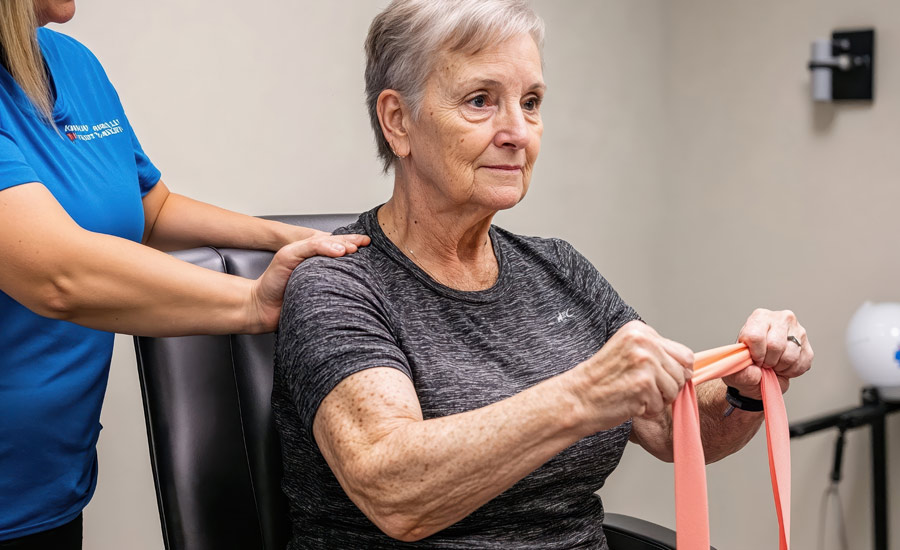How Physical Therapy in Care Homes Can Transform Your Loved One’s Life

Keeping mobile is essential to staying independent, reducing pain and feeling good. As mobility changes with age, physical therapy in care homes can keep residents active, recover from injuries and prevent falls.
Physical therapy is another way care homes can improve the health of residents in a sustainable way.
This article covers the physical therapy services available in care homes and how they make a difference.
What Physical Therapy Services Are Available in Care Homes?
Care homes offer a range of bespoke physical therapy services by trained professionals, including:
- Mobility training to help with walking, balance and coordination to improve confidence and independence.
- Strength and conditioning build muscle to prevent weakness and support daily movements.
- Post-surgery or injury rehabilitation aids recovery with targeted exercises and movement therapy.
- Fall prevention therapy focuses on balance exercises and techniques to reduce the risk of falls.
- Pain management uses physiotherapy techniques to ease joint pain, stiffness and chronic conditions.
- Flexibility and stretching programs improve range of motion and reduce stiffness for better mobility.
How Physical Therapy Improves Daily Life in Care Homes
Moving with ease makes everyday life smoother – whether that’s walking to the dining room, getting dressed without struggle or feeling steady on your feet. Physical therapy keeps residents mobile, reduces pain and builds confidence so they can stay as independent as possible.
Balance and strength exercises make a real difference in standing up, moving around safely and preventing falls. For those recovering from surgery or an injury, physical therapy speeds up healing and keeps future problems at bay.
Staying active also lifts mood, eases stiffness and keeps joints from seizing up. When movement feels easier, life feels better, so it’s important to encourage residents to join in on activities and take a short walk, helping them feel more in control.
Personalised Therapy Plans for Residents
Custom therapy plans keep residents moving, comfortable and independent.
Here’s how care homes create therapy plans that work:
Full mobility assessments
Therapists check strength, balance and any mobility issues to understand what support is needed.
Modified exercises
Plans are based on individual needs, whether gentle stretches to ease stiffness or strength exercises to improve walking and balance.
Recovery support
For residents recovering from surgery, injury or illness, therapy focuses on safe movement and rebuilding confidence.
Regular progress checks
Therapy plans aren’t set in stone. Exercises are adjusted as residents improve or if their needs change.
Pain management through movement
Stretching, strengthening and mobility work can help ease joint pain and stiffness, making everyday tasks easier.
Encouraging independence
The focus is on exercise that makes sure residents stay flexible and mobile so they can keep doing the things they enjoy.
Group Exercise and Social Engagement
Care homes offer a mix of gentle, low-impact activities to keep residents moving while giving them a chance to connect with others:
Light Exercise, Big Benefits
Group sessions include chair yoga, gentle stretching and balance exercises with specialised equipment to facilitate mobility, coordination and strength in a relaxed, pressure-free way.
Fall Prevention That Feels Natural
Classes centre on balance and stability, giving elderly residents more confidence when moving around while reducing the risk of falls.
A Social Boost with Every Session
Socialising is another important part of care home life. So having a laugh, swapping stories and moving together makes exercise something to look forward to. It’s movement but without the pressure.
No One Is Left Out
Activities are adapted for different abilities, so participants can take part at their own pace, whether they prefer seated exercises or can manage more movement.
Music and Movement to Lift Spirits
Some sessions include rhythmic movement, dance-based exercises or music therapy, making physical activity more stimulating and enjoyable.
Motivation to Keep Moving
A set routine helps residents stay consistent, build confidence and feel the benefits over time – without feeling like a strict workout plan.
How Carers Can Help Residents with Exercise and Physical Therapy
Daily movement is just as important as scheduled therapy sessions and care home staff are there to assist residents in staying healthy, strong and confident in their movement.
Physiotherapists might set the plan, but it’s carers who make sure residents keep making progress in between sessions.
Encouraging movement throughout the day keeps joints loose and muscles working. Care teams might support short walks, help with stretches or organise seated exercises to make sure residents stay as active as possible. Small, regular movements will maintain mobility and prevent stiffness, especially for those with limited movement.
For residents who need extra support, staff assist with safe transfers, positioning and mobility aids to prevent discomfort and reduce fall risks. They also monitor any changes in mobility or pain levels and work with therapists to adjust routines when needed.
Staff also help residents feel more capable, offer reassurance when needed and celebrate progress so therapy feels like a natural part of daily life rather than a task to complete.
Keeping Movement a Part of Everyday Life
Regular physical therapy sessions in care homes ensure that mobility stays a priority. This is something that is a major concern when ageing and is a huge factor in living a healthy, happy life.
Families can also get involved by asking about available exercise options and encouraging their loved ones to stay as active as possible. Keeping moving, even in small ways, can make a real difference to overall well-being.
Ready to explore...
